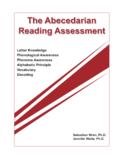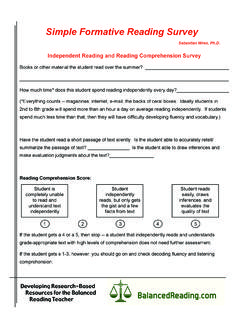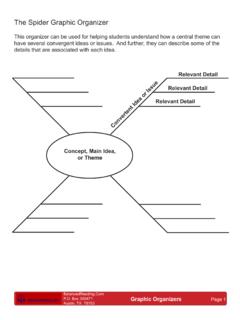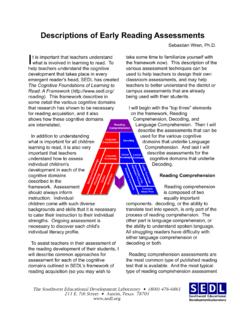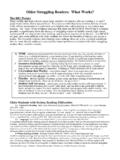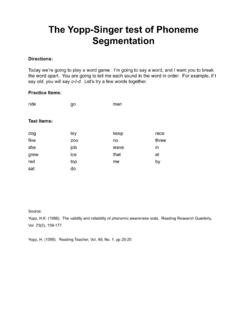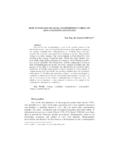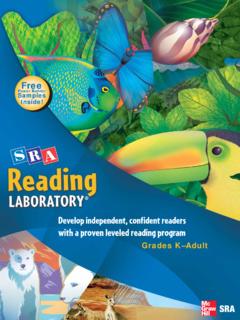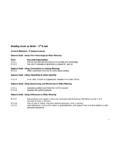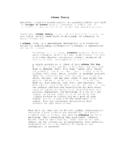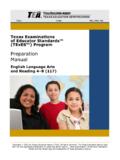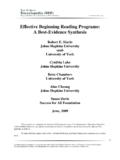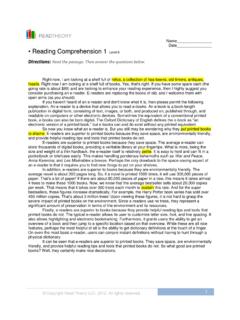Transcription of The Brain and Reading - Balanced Reading
1 The Brain and ReadingSebastian Wren, Southwest Educational Development Laboratory (800) 476-6861211 E. 7th Street Austin, Texas EducationalDevelopment LaboratoryWith a PET scan (above left), radioactive glucose isinjected into the blood stream. The most activeneurons absorb more of the radioactive glucose, so itis easy to take a picture of the Brain s activity duringdifferenttasks. With an MRI (above right), magneticfields are generated that cause the nuclei of theneurons to line up, making it possible to take adifferent kind of picture of the Brain s you read this passage quietly toyourself, certain parts of your Brain areworking to try to make sense of differentaspects of the information contained in thistext.
2 We can actually take a picture of theactivity in the Brain as its owner engages incertain behaviors (using either a PET scan oran MRI), and the picture tells us what parts ofthe Brain are most active during that outer surface of the Brain (called theNeocortex) is functionally divided into fourlobes the frontal lobe at the front of thehead, the occipital lobe at the back of thehead, the temporal lobe on the side, and theparietal lobe on the now, as you read this passage oftext, your occipital cortex is very active,processing all of the visual information youare encountering the words, the letters, andthe features of the letters. The frontal lobe ofyour neocortex is engaged in processing themeaning of the text you re Reading themeanings of the words, the sentences, andthe big picture, and it is working to relate whatyou are Reading with what you already , your temporal lobe (particularlyon the left side of your Brain if you re righthanded) is also active right now, processingall of the sounds associated with Reading even though you re Reading silently toyourself, the areas of the Brain that processspeech sounds are active just like they wouldbe if you were listening to somebody Brain is very structured in the way itprocesses information.
3 Complex tasks suchas Reading a passage of text are broken downinto easier tasks, and the easier tasks aredistributed to the areas of the Brain thatspecialize in those it is impossible at this point todescribe what is happening at the cellularlevel in the Brain , at the gross level, whatseems to be happening is that the Brain isanalyzing text at three major levels thevisual features of the words and letters, thephonological representation of those words,and the meanings of the words andsentences. There are other parts of yourbrain that are also quite active when you arereading ( parts of the cerebellumcontrolling automatic eye movements, parts ofthe reticular formation responsible forattention, etc.)
4 , but the most significantactivity is that associated with these threeareas of is worth noting that the activityassociated with listening to aperson speak and theactivity associated withreading is very similar in both cases, thetemporal lobe(especially on the leftside in right-handedpeople) and the frontal lobe areactive processing sounds and meaning,respectively. It is only the addition of theactivity in the occipital lobe that separatesreading text from listening to speech, and thisis consistent with research on the cognitiveprocesses involved in Reading . Evidencesuggests that, in order to be able to read,children must be able to decode text,translating it into a speech form, and childrenmust also be able to understand spokenlanguage.
5 These two skills are thefoundations for Reading comprehension, andthey are reflected in the structure of theframework that is being describedhere. When examining ayoung, struggling readerdiagnostically, the first twoquestions that a teachershould ask are, Does shehave trouble understanding mewhen I m talking to her or readingaloud to her? and Does she haveany difficulty decoding text especiallyunfamiliar text? If a child is having difficultyreading, the answer to one or both of thesequestions is sure to be, yes. Note from the author: There are atroubling number of Reading programs outthere that claim to be Brain based. Theseprograms allege that they were created basedon the most current Brain research available.
6 Ironically, the citations often givenas research support for these Brain -basedreading programs include early 20th centuryRussian philosopher / researchers AlexandrLuria and Lev Vygotsky, as well as RogerSperry (who worked with split- Brain patients inthe 1960s). The claims made by thesereading programs are troubling for threereasons. First, the research that is often citedis far from current, and much of what is putforth as current research evidence is, in fact,more philosophy than current, rigorousscience. Second, to the extent that good,reputable research is cited, the connectionsbetween those research findings and thereading program are unclear. Third, and mosttroubling, very often what is known about thebrain and neuroscience is horriblymisrepresented by proponents of thesereading programs.
7 Case in point adescription of the research base for onepopular Brain -based Reading programsuggested (among other things) that aschildren learn new information, their neuronsmyelinate, and it was alleged that this readingprogram was designed to enhance themyelination of children s neurons. Neither ofthese claims is true myelination has nothingto do with learning new information, andfurther, there was no way they couldlegitimately make the claim that their readingprogram enhances the myelination is a relatively new field, andthe best researchers in the field do not knowmuch more about the operations of the brainduring Reading than what has been describedin this short article.
8 It has been said that weknow considerably less about the workings ofthe human Brain than we know about distantstars and galaxies in our universe. We arelearning a great deal, but there is a great dealmore to be learned. For now, it is mostprudent to adopt a healthy skepticism aboutclaims made about Brain -based readingprograms.
